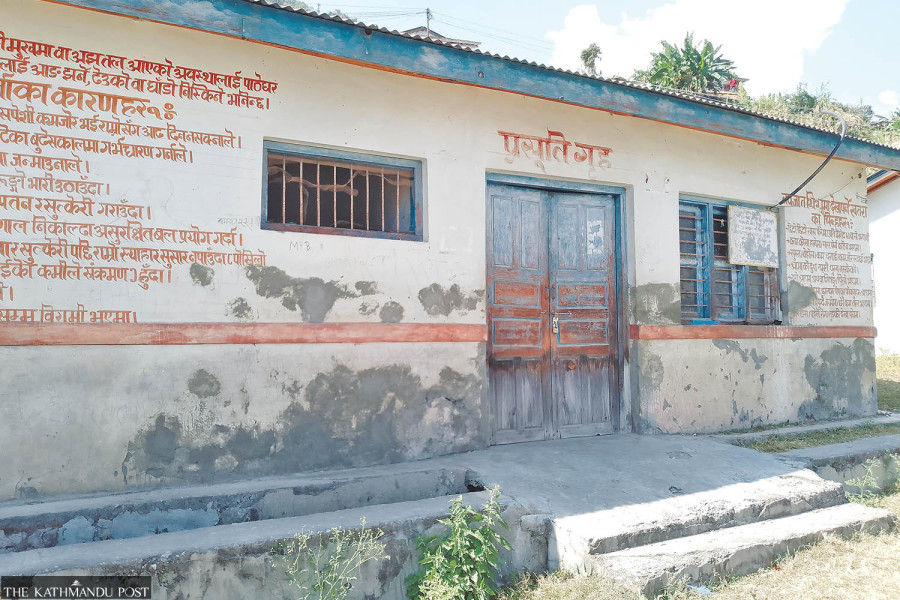Karnali Province
Power shortages cripple healthcare in remote Karnali districts
Thirteen local units in the province are without power, forcing medics to rely on torchlight for treatment after dark.
Tripti Shahi
At the Jaira Health Post in ward 1 of Sarkegad Rural Municipality, Humla, Auxiliary Nurse Worker Ramdevi Rawat has assisted in delivering around 80 babies over the past two years. Some of these deliveries were conducted at night, with attendants using a torchlight, as the health post lacked electricity. While a solar panel was installed two months ago, it has offered only limited relief. “The solar panel doesn’t work when there’s no sunlight,” Rawat said.
Many healthcare workers in the remote areas of Karnali Province are grappling with challenges due to the lack of electricity. Thirteen local units in the province remain without power, forcing health institutions to rely on torchlight to offer treatment services after dark.
Humla still lacks access to the national grid, while Mugu and Dolpa only gained connection last year. According to the NEA regional office, Rukum West is the most electrified district in Karnali, with 94 percent of households connected, whereas Humla has the lowest electrification rate at just 24 percent.
Adanchuli Rural Municipality in Humla has two health posts, three basic health centres, and four community health units. While both health posts rely on solar energy, the others operate without electricity. The small hydropower project in the village was destroyed by last year’s floods, exacerbating power shortages for local health institutions, according to Binod Budha, chief of the rural municipality’s health division. “We are using rechargeable flashlights to serve night-time patients, as the solar system only functions on sunny days,” he said.
Budha said the refrigerator used for storing medical supplies cannot operate due to the power shortage. As a result, health workers are forced to trek three days on foot to the district headquarters each month to collect vaccines. The baby warmer at the birthing centre also remains non-functional because of the electricity issue. In the cold Himalayan districts, using baby warmers is crucial, but the persistent power shortage has rendered it impossible.
“Currently, the reporting system is online, but due to the lack of electricity, we have to travel to Kolti in neighbouring Bajura district to submit our reports,” said Budha.
Karnali electrification programme in limbo
Data from the Nepal Electricity Authority’s regional office in Surkhet shows that 25.75 percent of households in Karnali remain without electricity. According to the 2021 National Population and Housing Census, 50 percent of households in the province still lack access to power.
The provincial government’s Karnali Ujyalo Programme, designed to expand electricity access across the province, has stalled. The government had pledged to provide electricity to 90 percent of households by 2023-24. Former Chief Minister Mahendra Bahadur Shahi initiated collaboration with the Alternative Energy Promotion Centre on January 21, 2020, to launch the programme.
A budget of Rs1.09 billion was allocated for the programme, but only 21 percent (Rs921.89 million) was spent. The programme stagnated after the federal government began supplying electricity through the national grid to villages. None of the small hydropower projects under the programme have been completed. The Chief Minister’s Office and the Council of Ministers allocated funds for 19 small and mini hydropower projects, with local governments tasked with their implementation.
Prem Bahadur Oli, an engineer at the Ministry of Water Resources and Energy Development, said the programme’s progress has been unsatisfactory due to consumer committees failing to meet their contractual obligations. He also highlighted that staff shortages have caused delays in the small hydropower projects. Nearly 100 million rupees have been allocated for the programme in the current fiscal year, but Oli raised concerns about the challenges of working with such a limited budget.
Karna Rokaya, deputy chief of Adanchuli Rural Municipality, said that despite appealing to both the provincial and federal governments for electricity, there has been no response. While solar power provides some support, work in the municipality comes to a halt when there is no sunlight or during rainy days. “Currently, all tasks are carried out online. Due to the lack of electricity, both service users and employees are facing difficulties,” he said.
He said that the 100-kilowatt small hydro project in the municipality was washed away by floods, forcing the local residents to live in darkness. He said work on another 100-kilowatt small hydro project for some wards is now in its final stages. Until the national transmission grid reaches, the community will continue to endure the hardships of darkness. “The lack of electricity has impacted the health sector. Students can’t study at night. Even now, we are forced to use torches to light up our surroundings,” he said.
Shambhu Kusiyat Yadav, chief engineer of the Nepal Electricity Authority’s regional office in Surkhet, said the government plans to fully electrify Karnali within the next year and a half. He added that a contract worth Rs12 billion has been awarded to implement the electrification project in the region.
The contract includes the installation of substations and the extension of power lines to households. However, Yadav highlighted that the region’s geographical challenges pose significant obstacles to the progress of electricity work in Karnali.
“Roads are closed for around six months due to rain and snow. In many areas without road access, transporting equipment is both time-consuming and costly,” he said.
According to Yadav, all manpower, including for pole installation, wire laying, and substation construction, has to be brought in from the Terai districts, which adds up to the challenge.




 18.24°C Kathmandu
18.24°C Kathmandu













